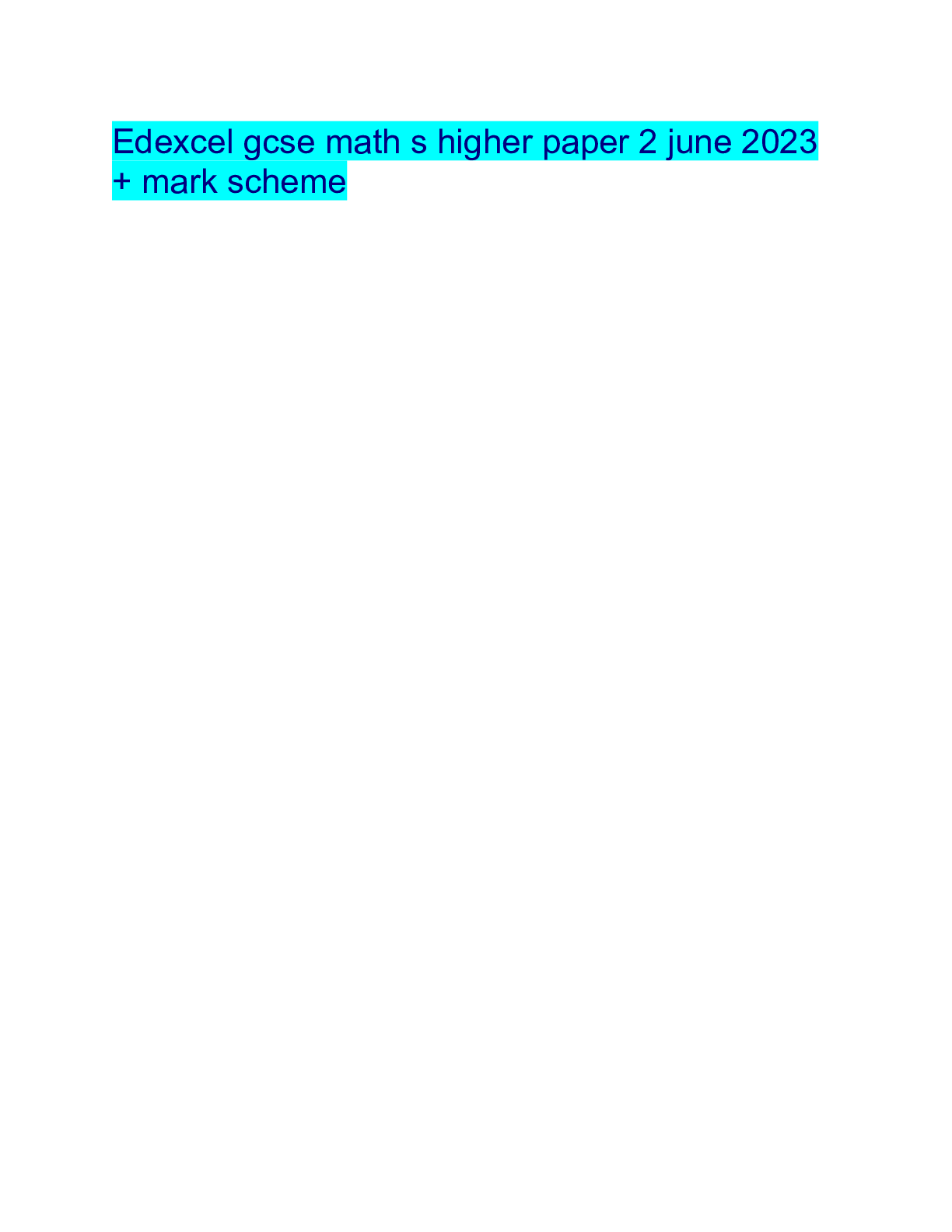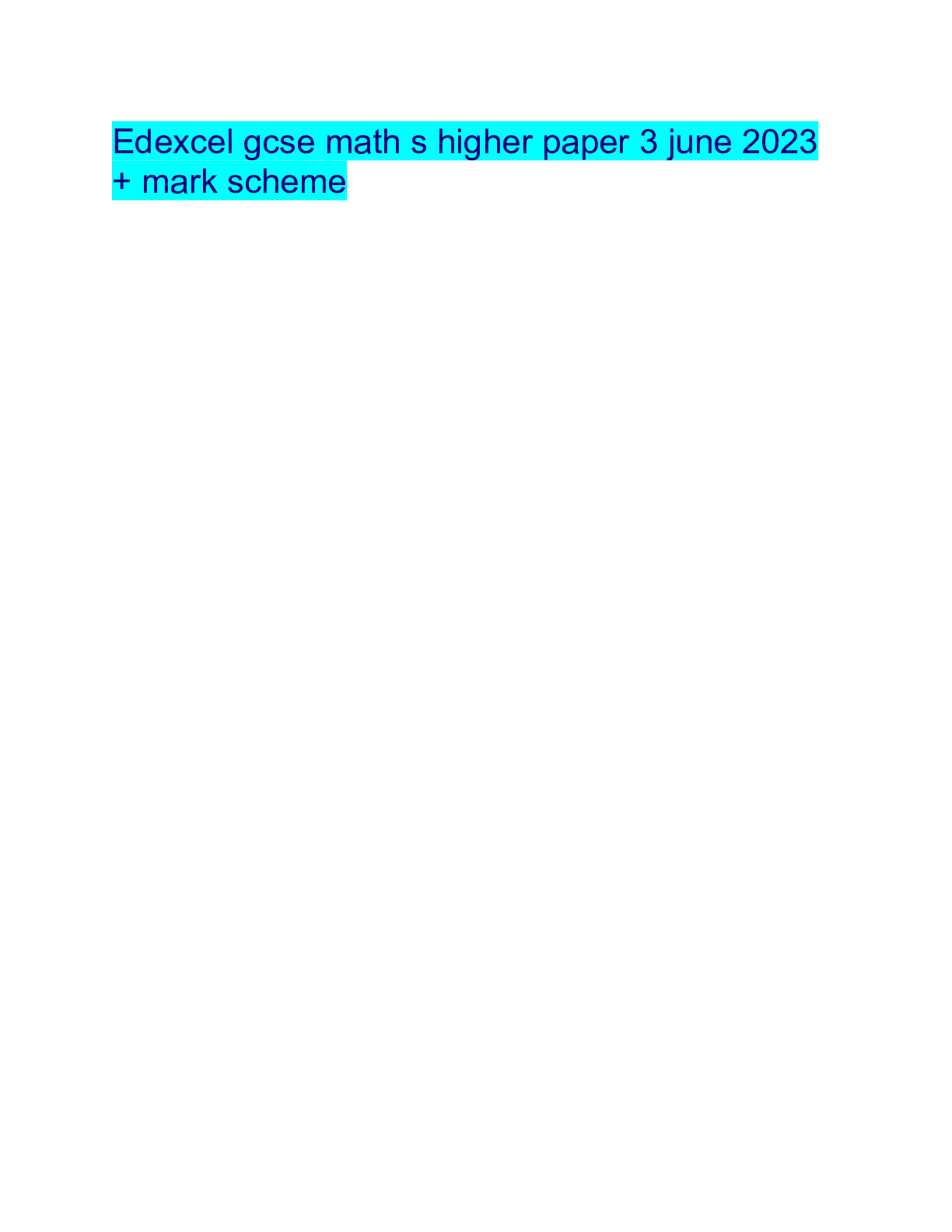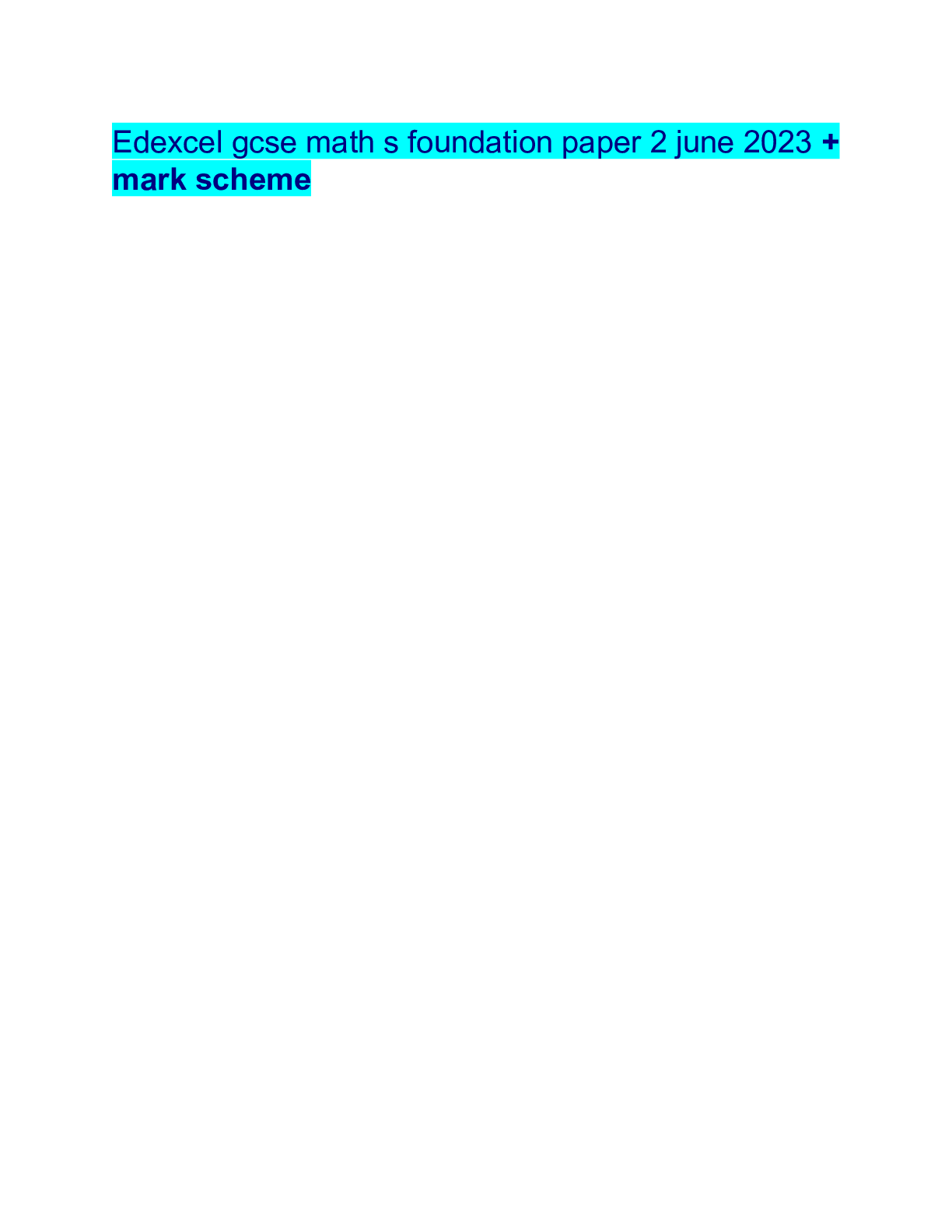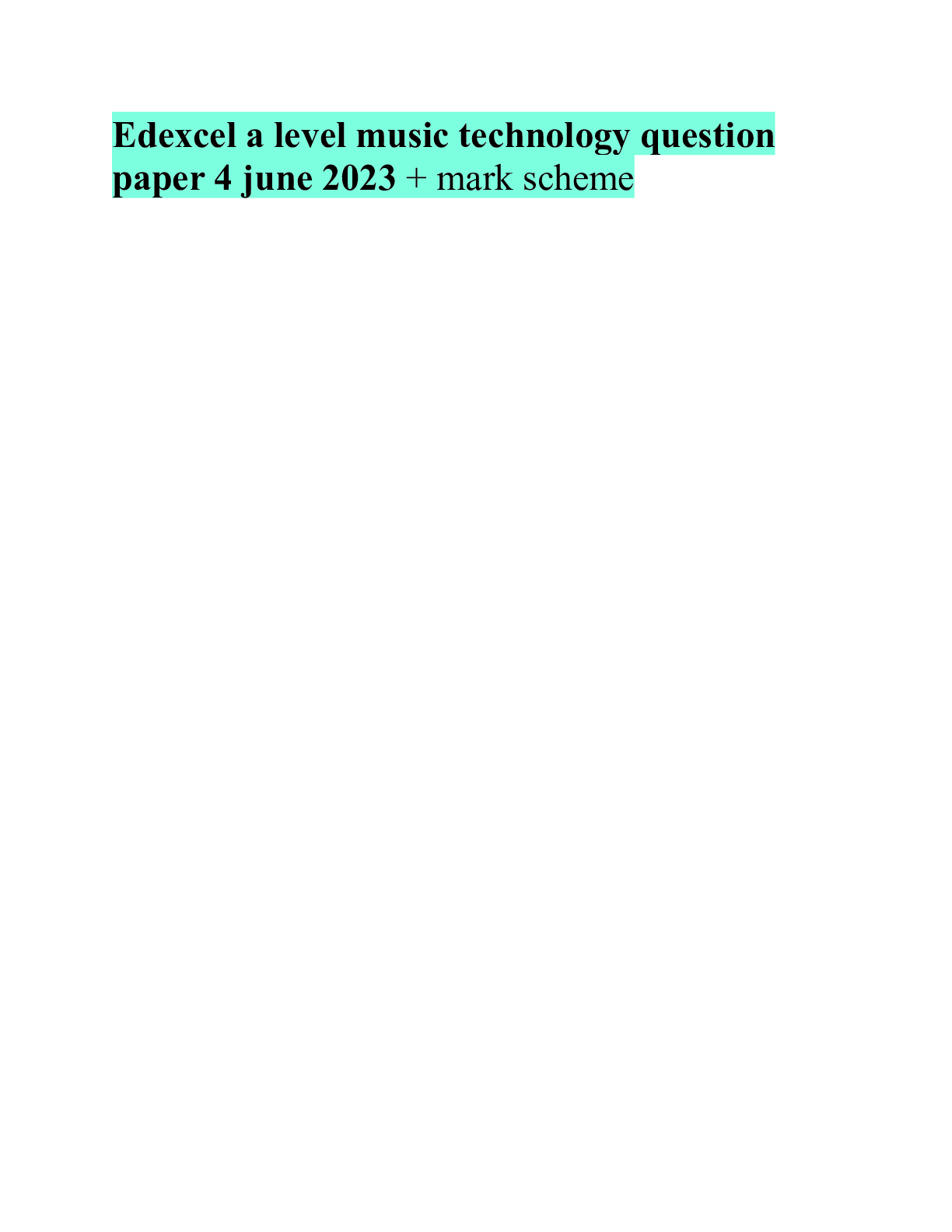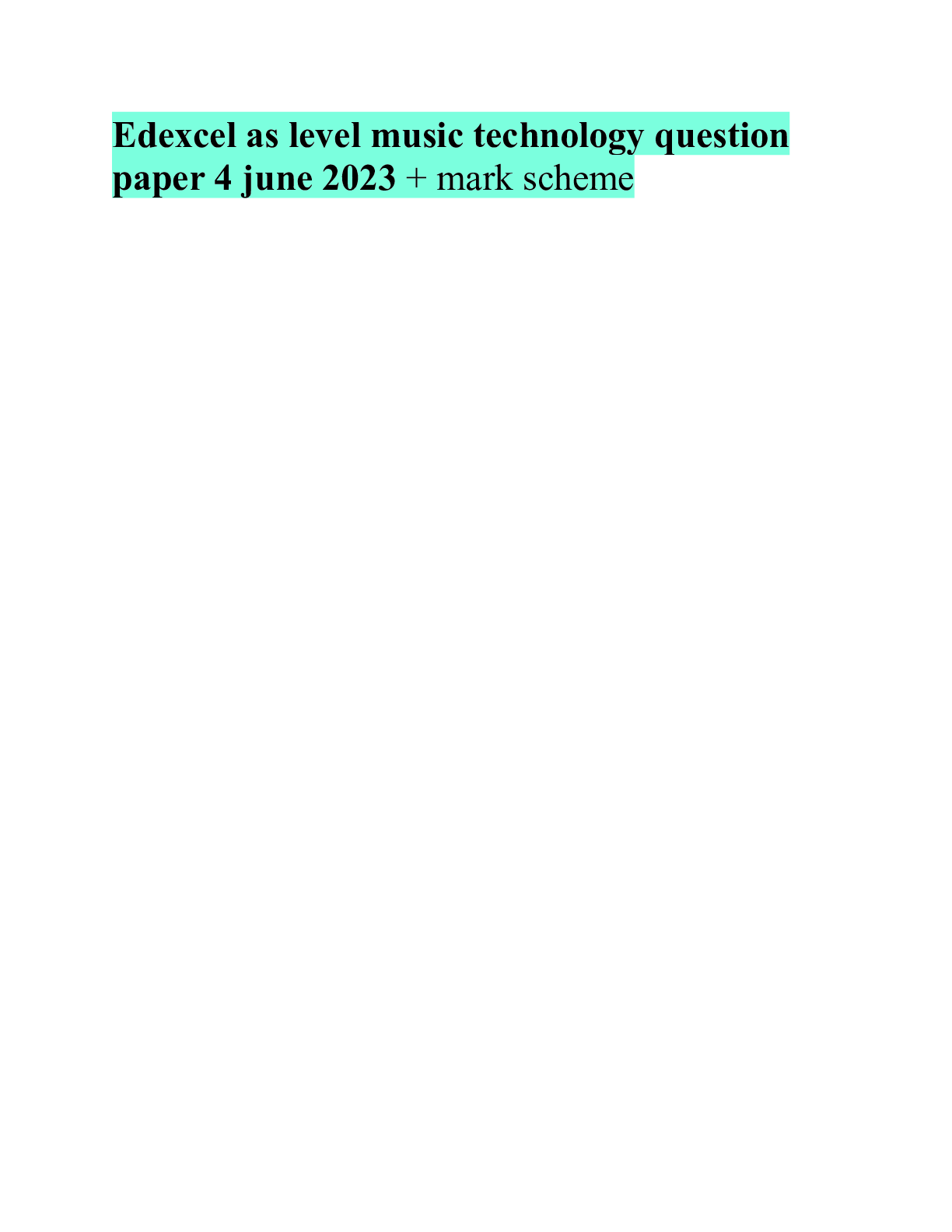Mathematics > Edexcel > Edexcel gcse math s higher paper 1 june 2023 + mark scheme (All)
Edexcel gcse math s higher paper 1 june 2023 + mark scheme
Document Content and Description Below
Mark Scheme (Results) Summer 2023 Pearson Edexcel GCSE In Mathematics (1MA1) Higher (Non-Calculator) Paper 1HEdexcel and BTEC Qualifications Edexcel and BTEC qualifications are awarded by Pearson... , the UK’s largest awarding body. We provide a wide range of qualifications including academic, vocational, occupational and specific programmes for employers. For further information visit our qualifications websites at www.edexcel.com or www.btec.co.uk. Alternatively, you can get in touch with us using the details on our contact us page at www.edexcel.com/contactus. Pearson: helping people progress, everywhere Pearson aspires to be the world’s leading learning company. Our aim is to help everyone progress in their lives through education. We believe in every kind of learning, for all kinds of people, wherever they are in the world. We’ve been involved in education for over 150 years, and by working across 70 countries, in 100 languages, we have built an international reputation for our commitment to high standards and raising achievement through innovation in education. Find out more about how we can help you and your students at: www.pearson.com/uk Summer 2023 Question Paper Log Number P75148 Publications Code 1MA1_1H_2306_MS All the material in this publication is copyright © Pearson Education Ltd 2023General marking guidance These notes offer general guidance, but the specific notes for examiners appertaining to individual questions take precedence. 1 All candidates must receive the same treatment. Examiners must mark the last candidate in exactly the same way as they mark the first. Where some judgement is required, mark schemes will provide the principles by which marks will be awarded; exemplification/indicative content will not be exhaustive. When examiners are in doubt regarding the application of the mark scheme to a candidate’s response, the response should be sent to review. 2 All the marks on the mark scheme are designed to be awarded; mark schemes should be applied positively. Examiners should also be prepared to award zero marks if the candidate’s response is not worthy of credit according to the mark scheme. If there is a wrong answer (or no answer) indicated on the answer line always check the working in the body of the script (and on any diagrams), and award any marks appropriate from the mark scheme. Questions where working is not required: In general, the correct answer should be given full marks. Questions that specifically require working: In general, candidates who do not show working on this type of question will get no marks – full details will be given in the mark scheme for each individual question. 3 Crossed out work This should be marked unless the candidate has replaced it with an alternative response. 4 Choice of method If there is a choice of methods shown, mark the method that leads to the answer given on the answer line. If no answer appears on the answer line, mark both methods then award the lower number of marks. 5 Incorrect method If it is clear from the working that the “correct” answer has been obtained from incorrect working, award 0 marks. Send the response to review for your Team Leader to check. 6 Follow through marks Follow through marks which involve a single stage calculation can be awarded without working as you can check the answer, but if ambiguous do not award. Follow through marks which involve more than one stage of calculation can only be awarded on sight of the relevant working, even if it appears obvious that there is only one way you could get the answer given.7 Ignoring subsequent work It is appropriate to ignore subsequent work when the additional work does not change the answer in a way that is inappropriate for the question or its context. (eg an incorrectly cancelled fraction when the unsimplified fraction would gain full marks). It is not appropriate to ignore subsequent work when the additional work essentially makes the answer incorrect (eg. incorrect algebraic simplification). 8 Probability Probability answers must be given as a fraction, percentage or decimal. If a candidate gives a decimal equivalent to a probability, this should be written to at least 2 decimal places (unless tenths). Incorrect notation should lose the accuracy marks, but be awarded any implied method marks. If a probability fraction is given then cancelled incorrectly, ignore the incorrectly cancelled answer. 9 Linear equations Unless indicated otherwise in the mark scheme, full marks can be gained if the solution alone is given on the answer line, or otherwise unambiguously identified in working (without contradiction elsewhere). Where the correct solution only is shown substituted, but not identified as the solution, the accuracy mark is lost but any method marks can be awarded (embedded answers). 10 Range of answers Unless otherwise stated, when an answer is given as a range (eg 3.5 – 4.2) then this is inclusive of the end points (eg 3.5, 4.2) and all numbers within the range 11 Number in brackets after a calculation Where there is a number in brackets after a calculation eg 2 × 6 (=12) then the mark can be awarded either for the correct method, implied by the calculation or for the correct answer to the calculation. 12 Use of inverted commas Some numbers in the mark scheme will appear inside inverted commas eg “12” × 50 ; the number in inverted commas cannot be any number – it must come from a correct method or process but the candidate may make an arithmetic error in their working. 13 Word in square brackets Where a word is used in square brackets eg [area] × 1.5 : the value used for [area] does not have to come from a correct method or process but is the value that the candidate believes is the area. If there are any constraints on the value that can be used, details will be given in the mark scheme. 14 Misread If a candidate misreads a number from the question. eg uses 252 instead of 255; method or process marks may be awarded provided the question has not been simplified. Examiners should send any instance of a suspected misread to review.Guidance on the use of abbreviations within this mark scheme M method mark awarded for a correct method or partial method P process mark awarded for a correct process as part of a problem solving question A accuracy mark (awarded after a correct method or process; if no method or process is seen then full marks for the question are implied but see individual mark schemes for more details) C communication mark awarded for a fully correct statement(s) with no contradiction or ambiguity B unconditional accuracy mark (no method needed) oe or equivalent cao correct answer only ft follow through (when appropriate as per mark scheme) sc special case dep dependent (on a previous mark) indep independent awrt answer which rounds to isw ignore subsequent workingPaper: 1MA1/1H Question Answer Mark Mark scheme Additional guidance 1 56.4 M1 for a start to a method, eg 846 ÷ 15 or 8.46 ÷ 0.15 or 8.46 ÷ 3 × 20 or 282 ÷ 5 that leads to 5 as the first digit or for a complete method with no more than one arithmetic error A start to a repeated subtraction method or a build-up method is acceptable if a correct first digit of 5 is found A1 for digits 564 identified A1 (ft) dep on M1 for correct placement of the decimal point into their final answer An answer of 56 2 5 gets 3 marks 2 4 7 8 M2 for a complete method, eg 7 – 2 + 3 8 − 4 8 condoning error with one numerator or for 59 8 − 5 2 = 59 8 − 20 8 (= 39 8 ) with no more than one error OR for an answer of 4.875 (M1 for finding two fractions with a correct common denominator, with at least one correct corresponding numerator, eg 3 8 , 4 8 or for converting both to improper fractions, eg 59 8 , 5 2 OR for 7.375 – 2.5 ) At least one improper fraction must be correct Both decimals must be correct A1 for 4 7 8 oe eg 14 4 16 Any equivalents must be a mixed numberPaper: 1MA1/1H Question Answer Mark Mark scheme Additional guidance 3 125 P1 for process to find area of one face, eg 150 ÷ 6 (= 25) or 6x2 = 150 where x is the length of one side P1 for process to find side length, eg √"25" (= 5) P1 for a complete process to find volume, eg “5” × “5” × “5” or “25” × “5” A1 cao 4 Frequency polygon drawn B2 for fully correct frequency polygon with points plotted at the midpoints Joining must be with line segments Accept points plotted within half a small square Ignore any histogram drawn and any part of a frequency polygon outside range of first and last points plotted (2.5, 8), (7.5, 24) (12.5, 13) (17.5, 11) (22.5, 4) (B1 for all points plotted correctly but not joined with line segments or points plotted at correct heights not at midpoints but consistently within each interval and joined with line segments or correct frequency polygon with one point incorrect or correct frequency polygon with first and last points joined directly) for example, at 0, 5, 10,…or at 5, 10, 15,…Paper: 1MA1/1H Question Answer Mark Mark scheme Additional guidance 5 (a) Venn diagram B3 for a fully correct Venn diagram Ignore all entries except the region you are marking for each method mark (B2 for two or three of the four regions correct) (B1 for just one of the four regions correct) (b) 7 10 M1 (ft diagram) for 𝑎 10 where 0 < a < 10 and a is an integer or 7 𝑏 where b > 7 and b is an integer or 1 − 3 10 or 7 : 10 Repeated digits in the diagram should be counted as 2 elements A1 (ft diagram) for 7 10 oe Accept any equivalent fraction, or 0.7 or 70% 3 1 4 2 9 5 7 6 8 10Paper: 1MA1/1H Question Answer Mark Mark scheme Additional guidance 6 (a) Description C1 for a valid description of the relationship Acceptable examples As age increases, weight increases The older you are the greater the weight Positive correlation Not acceptable examples Positive (relationship) age and weight are in proportion strong correlation or correlation is increasing as the babies get older the heavier they get, negative correlation they are directly proportional, weight goes up as age goes up Accept positive correlation Ignore any comment about strength (b) 2.5 to 4.5 B2 for an answer in the range 2.5 to 4.5 (B1 for a suitable line of best fit drawn or for a point on the grid at (x, 5.8) where x lies between 2.5 and 4.5 or a horizontal line drawn from 5.8 across to (x, 5.8) where x is in the range 2.5 to 4.5) 7 1200 M1 for a fully correct method, eg 240 ÷ 0.2 or 240 × 5 oe A1 cao SC B1 for an answer of 960 or 1440 if M0 scored 8 3 P1 for process to find area of base, eg 1200 ÷ 40 (= 30) P1 for process to find pressure, eg 90 ÷ “30” A1 caoPaper: 1MA1/1H Question Answer Mark Mark scheme Additional guidance 9 x = 6 y = −2 B1 cao 10 140 P1 for process to find sum of the interior angles of a pentagon eg 180 × (5 – 2) (= 540) oe Angles must be clearly labelled on the diagram or otherwise identified. Correct method can be implied from angles on the diagram if no ambiguity or contradiction. Ratio must be used correctly if awarded for diagram P1 (dep P1) for process to use ratio 4 : 1, eg labels as 4x and x or as x and 1 4 x or 110 + 135 + 120 + 4x + x = “540” or for “540” – 110 – 135 – 120 (= 175) P1 for process to find angle ABC or angle AED eg “175” ÷ (4 + 1) (= 35) or “175” ÷ (4 + 1) × 4 A1 cao A correct answer with no supportive working gets 0 marksPaper: 1MA1/1H Question Answer Mark Mark scheme Additional guidance 11 3x7y2 M1 for full evaluation of numerator or denominator with at least 2 of 3 terms correct in a product, eg 36x10y6 or 12x3y4 or full evaluation of 5 3 2 7 6 3 x y x y or 5 3 3 6 4 x y xy − with at least 2 of 3 terms correct in a product, eg 2x3y–4 or 1.5x4y6 M1 for correct evaluation of numerator and denominator, eg 36x10y6 and 12x3y4 or for full evaluation of numerator and denominator with no more than one error and a final answer of the form axbyc with two of a, b and c correct or for correct evaluation of 5 3 2 7 6 3 x y x y and 5 3 3 6 4 x y xy − eg 2x3y–4 and 1.5x4y6 or for full evaluation of 5 3 2 7 6 3 x y x y and 5 3 3 6 4 x y xy − with no more than one error and a final answer of the form axbyc with two of a, b and c correct A1 for 3x7y2 oe Accept a = 3, b = 7, c = 2Paper: 1MA1/1H Question Answer Mark Mark scheme Additional guidance 12 62 72 M1 for one correct product, eg 5 7 8 9 (= 35 72 ) oe or 3 2 8 9 (= 6 72 ) oe or 3 7 8 9 (= 21 72 ) oe or 5 2 8 9 (= 10 72 ) oe M1 for a full method, eg 5 7 3 2 3 7 8 9 8 9 8 9 + + oe or 5 2 1 8 9 − oe A1 for 62 72 oe eg 31 36 13 80 M1 for setting up an equation with a constant term, eg y = kx oe or 24 = k × 1.5 oe or k = 16 or for starting to work with direct proportion, eg 24 ÷ 1.5 (= 16) or 5 ÷ 1.5 (= 3.33…) Condone the use of “α ” instead of “=” for the M marks M1 for substituting in y = kx, eg y = “16” × 5 or for a complete method, eg [Show More]
Last updated: 3 months ago
Preview 1 out of 51 pages
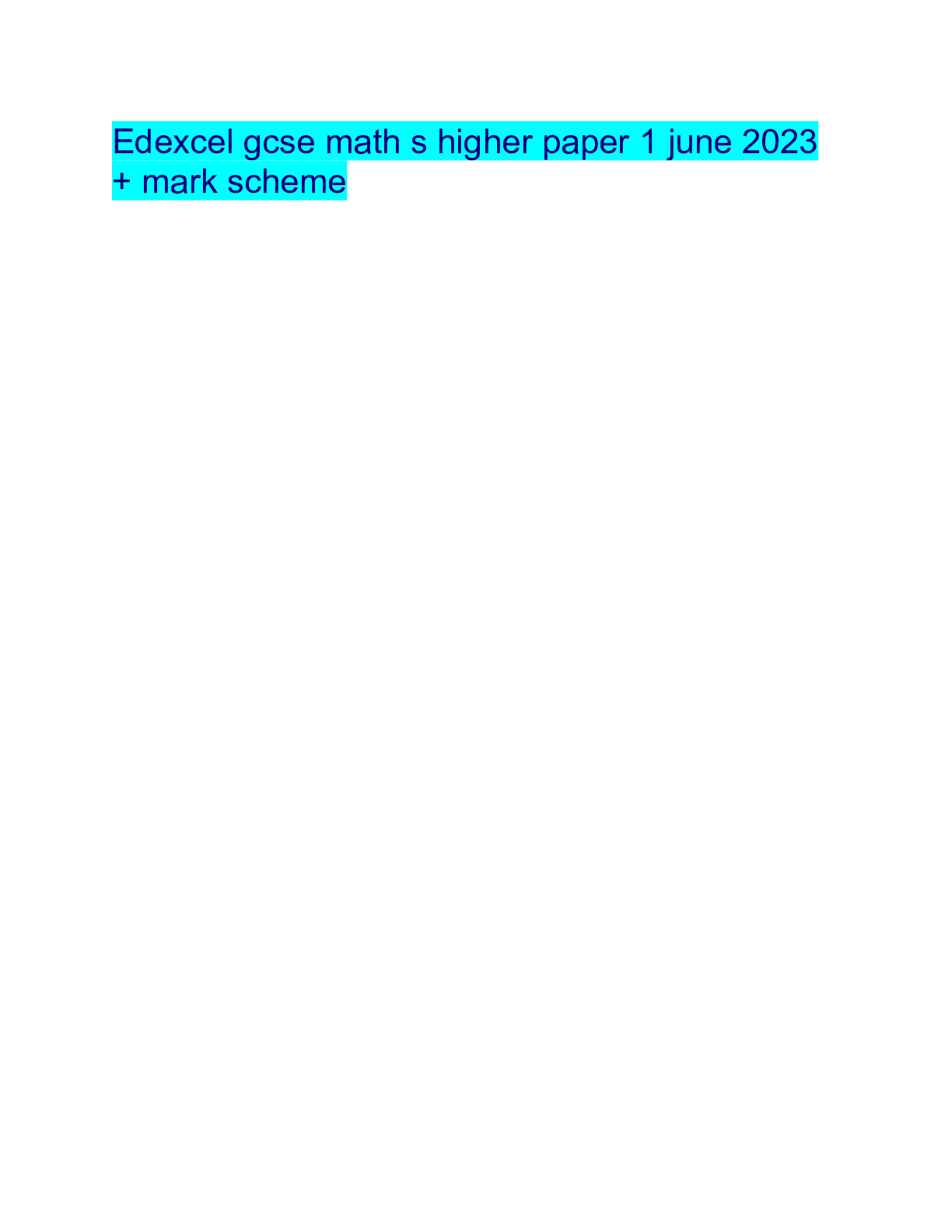
Reviews( 0 )
Document information
Connected school, study & course
About the document
Uploaded On
Jan 16, 2024
Number of pages
51
Written in
Additional information
This document has been written for:
Uploaded
Jan 16, 2024
Downloads
0
Views
23

.png)
.png)
.png)
.png)
.png)
.png)
.png)
.png)
.png)
.png)
.png)
.png)
.png)
.png)


